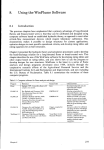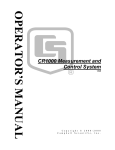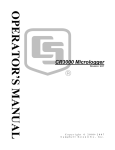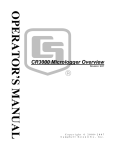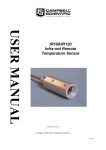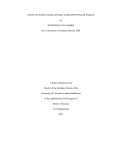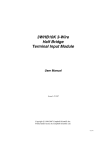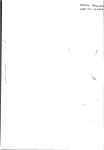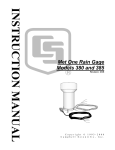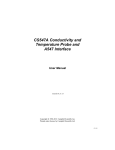Download Campbell DB1 Specifications
Transcript
DB1 Liquid Level Measurement Sensor Revision: 12/07 C o p y r i g h t © 1 9 9 3 - 2 0 0 7 C a m p b e l l S c i e n t i f i c , I n c . Warranty and Assistance The DB1 LIQUID LEVEL MEASUREMENT SENSOR is warranted by CAMPBELL SCIENTIFIC, INC. to be free from defects in materials and workmanship under normal use and service for twelve (12) months from date of shipment unless specified otherwise. Batteries have no warranty. CAMPBELL SCIENTIFIC, INC.'s obligation under this warranty is limited to repairing or replacing (at CAMPBELL SCIENTIFIC, INC.'s option) defective products. The customer shall assume all costs of removing, reinstalling, and shipping defective products to CAMPBELL SCIENTIFIC, INC. CAMPBELL SCIENTIFIC, INC. will return such products by surface carrier prepaid. This warranty shall not apply to any CAMPBELL SCIENTIFIC, INC. products which have been subjected to modification, misuse, neglect, accidents of nature, or shipping damage. This warranty is in lieu of all other warranties, expressed or implied, including warranties of merchantability or fitness for a particular purpose. CAMPBELL SCIENTIFIC, INC. is not liable for special, indirect, incidental, or consequential damages. Products may not be returned without prior authorization. The following contact information is for US and International customers residing in countries served by Campbell Scientific, Inc. directly. Affiliate companies handle repairs for customers within their territories. Please visit www.campbellsci.com to determine which Campbell Scientific company serves your country. To obtain a Returned Materials Authorization (RMA), contact CAMPBELL SCIENTIFIC, INC., phone (435) 753-2342. After an applications engineer determines the nature of the problem, an RMA number will be issued. Please write this number clearly on the outside of the shipping container. CAMPBELL SCIENTIFIC's shipping address is: CAMPBELL SCIENTIFIC, INC. RMA#_____ 815 West 1800 North Logan, Utah 84321-1784 CAMPBELL SCIENTIFIC, INC. does not accept collect calls. DB1 Table of Contents PDF viewers note: These page numbers refer to the printed version of this document. Use the Adobe Acrobat® bookmarks tab for links to specific sections. 1. Overview.......................................................................1 2. Specifications ..............................................................2 3. Installation....................................................................2 4. Wiring............................................................................3 5. Programming ...............................................................6 5.1 CR1000 Example......................................................................................6 5.2 CR10(X) Example ....................................................................................7 6. Maintenance ...............................................................10 6.1 6.2 6.3 6.4 Periodic Maintenance .............................................................................11 Solenoid Valve .......................................................................................11 Fittings ....................................................................................................11 Needle Valve ..........................................................................................11 7. Replacement Parts ....................................................12 Figures 1 and 2. The DB1 System ...............................................................................4 3. Wiring Diagram for DB1............................................................................5 This is a blank page. i This is a blank page. DB1 Liquid Level Measurement Sensor 1. Overview The double bubbler is a self-calibrating system for liquid level measurement. This manual focuses on water level measurement in stilling wells or open channels, but the information applies to other liquids as well. The system detects water level by measuring the pressure required to force a nitrogen gas bubble from a submerged tube. The nitrogen pressure in the tube is equal to the hydrostatic pressure created by the exiting bubble. Before each stage measurement, the pressure transducer is calibrated by measuring the hydrostatic pressure difference between two tubes installed a fixed vertical distance apart in the liquid to be measured. These values are used to calculate the multiplier value for the liquid level measurement. This self-calibration minimizes the effects of temperature and long-term drift on the pressure transducer, allowing a single pressure transducer to achieve a much higher measurement accuracy (±.05%). The self-calibration theory is discussed in detail by Dedrick and Clemmens (1984, 1986). A single pressure transducer is used to measure three pressure lines (h1, h2, or offset). The line to be measured is controlled by the three 2-way solenoid valves on the manifold. The "bubble rate" is controlled by the two needle valves on the manifold assembly labeled #1 and #2. The needle valve labeled #1 controls the bubble rate for the pressure line used to measure h1. The needle valve labeled #2 controls the bubble rate for pressure line #2 used to measure h2. The needle valve is turned clockwise to decrease and counterclockwise to increase the bubble rate. The suggested bubble rate is 1 to 3 bubbles/sec. The third solenoid valve is used to measure atmospheric pressure, which will be used as the offset value. The manifold assembly requires considerably more power compared to a normal sensor. For this reason, an SP10 10-watt solar panel or AC power in conjunction with a sealed rechargeable battery is recommended for the DB1 system. References Dedrick, A.R. and A.J. Clemmens, Double-bubblers coupled with pressure transducers for water level sensing, Transactions of the ASAE, Vol. 27, No. 3, pp. 779-783, 1984. Dedrick, A.R. and A.J. Clemmens, Instrumentation for monitoring water levels, Proc. of Agri- Mation Conference and Exposition, ASAE, March 3-5, Chicago, IL, pp. 148-152, 1986. 1 DB1 Liquid Level Measurement Sensor 2. Specifications Measurement Range: Option - 5 Option - 15 Option - 30 (0 to 5 psi/0 to 11.5 ft.) (0 to 15 psi/0 to 34.5 ft.) (0 to 30 psi/0 to 69 ft.) Maximum Overpressure Range: Option - 5 Option - 10 Option - 15 20 psi 45 psi 60 psi Transducer Accuracy: ± 0.05 % Full Scale Temperature Range: -25° to + 50°C Supply Voltage: 12 Vdc System Current Drain: 75 mA (Activated) 0.5 mA (Quiescent) Valve Current Drain: 40 mA (Activated) 0 mA (Deactivated) Maximum System Pressure: 100 psi 3. Installation Mount the DB1 liquid level assembly to the enclosure back-plate using the supplied plastic screw grommets and Phillips screws. Using the supplied tubing cutter, cut sections of tubing for the nitrogen, h1, h2, and offset pressure lines. Insert the h1 pressure line into the elbow fitting below the valve marked #1. The line is installed correctly when it does not release without pressing the red fitting into the valve assembly. Insert the h2 pressure line into the elbow fitting below the valve marked #2. Insert the offset line into the elbow fitting to the right of the valve marked #2. Insert the nitrogen supply line into the elbow fitting on the right side of the manifold assembly. Permanently install h1 and h2 a fixed vertical distance apart in the water (see Figure 2, delta h). Maximize the fixed distance between h1 and h2, while keeping h1 at least six inches below the surface of the lowest anticipated water level. If the water level drops below h1 you will get irregular data readings. The accuracy of the water level measurement is affected by the exactness of the delta h measurement. To increase measurement accuracy, cut the end of the submerged tubing at a 60 degree angle to decrease the gas bubble deformation as it exits the tube. The DB1 Liquid Level System requires a compressed gas supply. The most common gas is a 225 ft3 nitrogen bottle with an appropriate "automatic pressure relieved" pressure regulator. The pressure range set on the regulator depends on the water level to be recorded. For example, if the DB1 system is installed in a stilling well to measure stream level, and the stream level 2 DB1 Liquid Level Measurement Sensor fluctuates between 5 and 15 ft (2.2 and 6.5 psi), set the pressure regulator above 7 psi (read 10 psi) to ensure adequate pressure. Open the nitrogen bottle valve, set the pressure regulator, and adjust the nitrogen flow by adjusting the two needle valves. The suggested bubble rate is 1 to 3 bubbles/seconds. The nitrogen gas bottle, regulator, and tubing (Campbell P/N 7567) are available from any welding supply store. Use common sense when installing pressure lines, checking for leaks, moisture, kinks, etc. in the lines. The DB1 does not have a mechanism to stop the flow of gas through the two submerged tubes so gas will be flowing constantly. This is very effective in reducing the growth of biomass in the tubes, which could otherwise reduce or block the flow of gas. If you wish to conserve gas, you can install a 12 Vdc solenoid valve between the gas bottle and the DB1 manifold and use the SW12V port on the datalogger to open the valve just prior to a measurement. This will result in slower consumption of nitrogen but may result in biomass build-up in the mouth of the tubes. 4. Wiring Wiring connections for the CR800, CR850, CR1000, and CR10(X) dataloggers are shown in Figure 3. The channel numbering in the wiring diagram matches the channel usage in the program examples. The pressure transducer within the DB1 has four conductors (white, green, red, black). The white lead connects to the high side and the green lead connects the low side of any analog channel (e.g. 1H and 1L). The red lead connects to any excitation channel and the black lead connects to any analog ground channel. The three relay cable assemblies have three conductors for each valve. The green wires connect to control ports C1 (Valve #1), C2 (Valve #2), and C3 (Valve #3) as used in the program example that follow. The red wires connect to 12 volts, and the black wires connect to ground. The cable assemblies have been provided with extra lead length to enable the user to cut the cables to length to accommodate different size enclosures. 3 DB1 Liquid Level Measurement Sensor FIGURES 1 and 2. The DB1 System 4 DB1 Liquid Level Measurement Sensor CR10(X) CR1000, CR800, CR850, 21X FIGURE 3. Wiring Diagram for DB1 5 DB1 Liquid Level Measurement Sensor 5. Programming Every 60 seconds, the following program examples calculate the pressure transducer multiplier, measure the offset, and measure the liquid level. The average liquid level is stored in final memory every 15 minutes. 5.1 CR1000 Example 'CRBasic code for CR1000, CR800, or CR850 Public WtrLvl Public Batt_Volt Dim i Dim j Dim mv Dim Sum Dim Mult Dim Offset Dim Valve(3) Dim Delta_mV Const Delta_H = 'Set Delta_H equal to the vertical difference between the upper tube and lower tube. 'Unit of measurement of Delta_H will determine unit of measurement of final output. '\\\\\\\\\\\\\\\\\\\\\\\\ OUTPUT SECTION //////////////////////// DataTable(Table1,true,-1 DataInterval(0,5,Min,10) Sample (1,WtrLvl,FP2) EndTable DataTable(Table2,true,-1) DataInterval(0,1440,min,10) Minimum(1,Batt_Volt,FP2,False,True) EndTable '\\\\\\\\\\\\\\\\\\\\\\\\\\\ PROGRAM //////////////////////////// BeginProg Scan(5,Min, 3, 0) Battery(Batt_Volt) For i = 1 To 3 Select Case i Case 1 PortSet(1,1) Case 2 PortSet(2,1) 6 'Open valve to lower tube 'Open valve to upper tube DB1 Liquid Level Measurement Sensor Case 3 PortSet(3,1) EndSelect 'Open valve to atmosphere Delay(0,150,MSEC) Sum = 0 For j = 1 To 25 'Take 25 pressure readings for each tube and atmosphere BrFull(mV, 1, mV25,4, VX1, 1, 2500, true, true, 0, _60Hz, 1, 0) Sum = Sum + mV Next j Valve(i)= Sum/25 'Average the 25 readings from upper and lower tube and atmosphere PortSet(1,0) 'Close valve to lower tube PortSet(2,0) 'Close Valve to upper tube PortSet(3,0) 'Close Valve to atmosphere Next i Delta_mV = Valve(2) - Valve(1) Mult = Delta_H/Delta_mV Offset = (Valve(3) * Mult) WtrLvl = Valve(2)* Mult – Offset 'units of WtrLvl are same units as Delta_H (a constant) CallTable Table1 NextScan EndProg 5.2 CR10(X) Example Input Location Usage: LOCATION LABEL #1: #4: #5: #6: #7: #8: #9: #10: #11: #12: #13: Liquid Level Multiplier Offset mv/V Sum Avg. Level mV/V#1 mV/V#2 mV/V#3 Delta V Delta h * Table 1 Programs 01: 60 Sec. Execution Interval 1: Do (P86) 1: 2 Call Subroutine 2 2: Do (P86) 1: 42 Set high Port 2 7 DB1 Liquid Level Measurement Sensor 3: Excitation with Delay (P22) 1: 1 EX Chan 2: 0 Delay w/EX (units=.01sec) 3: 150 Delay after EX (units=.01sec) 4: 0 mV Excitation Subroutine 1 measures the pressure in the tubing connected to the second value: 4: Do (P86) 1: 1 Call Subroutine 1 5: Do (P86) 1: 52 Set low Port 2 The following instructions convert the mV readings to engineering units: 6: Z=X*Y (P36) 1: 8 2: 4 3: 1 X Loc AVG LEVEL Y Loc MULT. Z Loc [:LEVEL#1 ] 7: Z=X+Y (P33) 1: 1 2: 5 3: 1 X Loc LEVEL#1 Y Loc OFFSET Z Loc [:LEVEL#1 ] 8: If time is (P92) 1: 0 minutes into a 2: 15 minute interval 3: 10 Set high Flag 0 (output) 9: Real Time (P77) 1: 110 Day,Hour-Minute 10: Average (P71) 1: 1 Rep 2: 1 Loc LEVEL#1 11: End Table 1 * Table 3 Subroutines Pressure Transducer Measurement Routine: 1: Beginning of Subroutine (P85) 1: 1 Subroutine Number 8 DB1 Liquid Level Measurement Sensor 2: Z=F (P30) 1: 0 2: 0 3: 7 F Exponent of 10 Z Loc [:SUM ] 3: Beginning of Loop (P87) 1: 0 Delay 2: 25 Loop Count 4: Full Bridge (P6) 1: 1 Rep 2: 23 25 mV 60 Hz rejection Range 3: 1 IN Chan 4: 1 Excite all reps w/EXchan 1 5: 2500 mV Excitation 6: 6 Loc [:mV/V ] 7: 1 Mult 8: 0 Offset 5: Z=X+Y (P33) 1: 7 2: 6 3: 7 X Loc SUM Y Loc mV/V Z Loc [:SUM ] 6: End (P95) 7: Z=X*F (P37) 1: 7 2: .04 3: 8 X Loc SUM F Z Loc [:AVG LEVEL] 08: End (P95) Subroutine 2 activates values #1 - #3, measures h1, h2, and atmospheric pressure, and calculates the multiplier and offset: 09: Beginning of Subroutine (P85) 1: 2 Subroutine Number 10: Beginning of Loop (P87) 1: 0 Delay 2: 3 Loop Count 11: Do (P86) 1: 41-- Set high Port 1 Note: The dashes (--) after 41 indicate at the next loop port 2 will be set high, then port 3. 12: Excitation with Delay (P22) 1: 3 EX Chan 2: 0 Delay w/EX (units=.01sec) 3: 150 Delay after EX (units=.01sec) 4: 0 mV Excitation 9 DB1 Liquid Level Measurement Sensor 13: Do (P86) 1: 1 Call Subroutine 1 14: Z=X (P31) 1: 8 2: 9-- X Loc AVG LEVEL Z Loc [:mV/V #1 ] 15: Do (P86) 1: 51-- Set low Port 1 16: End (P95) 17: Z=X-Y (P35) 1: 10 X Loc mV/V #2 2: 9 Y Loc mV/V #1 3: 12 Z Loc [:DELTA V ] Note: On the next command, enter the measured Delta h value for F, using the units (e.g. inches, cm, etc.) you want the data to be in on your printout. 18: Z=F (P30) 1: 0 2: 0 3: 13 F Exponent of 10 Z Loc [:DELTA H ] 19: Z=X/Y (P38) 1: 13 X Loc DELTA H 2: 12 Y Loc DELTA V 3: 4 Z Loc [:MULT. ] 20: Z=X*Y (P36) 1: 11 X Loc mV/V #3 2: 4 Y Loc MULT. 3: 5 Z Loc [:OFFSET ] 21: Z=X*F (P37) 1: 5 X Loc OFFSET 2: -1 F 3: 5 Z Loc [:OFFSET ] 22: End (P95) 23: End Table 3 6. Maintenance The user should review the Installation and Maintenance section in the appropriate datalogger manual. This section discusses maintenance required for components specific to the DB1 sensor. 10 DB1 Liquid Level Measurement Sensor 6.1 Periodic Maintenance • Inspect submerged bubbler tubes for sediment or other debris. Remove debris and clean tubes as required. • Replace submerged bubbler tubes if cracked or damaged. • Replace nitrogen bottle every 2 to 3 months depending on bubble rate. • Inspect valves for leaks every 2 to 3 months and tighten or replace as required (refer to discussion on valves below). • Inspect fittings for leaks every 2 to 3 months and replace as required. • Inspect desiccant indicator cards and replace desiccant when card begins to change color from blue to pink. 6.2 Solenoid Valve Over time, the knurled ring on the solenoid valve may become loose due to expansion and contraction. This problem is corrected by simply turning the knurled ring clockwise until finger tight. Two other possible problems are contamination or complete failure. In the case of contamination, the valve would not open or close properly, resulting in deviant pressure measurements. The solenoid valve can be disassembled to inspect for possible contamination by removing the top half of the valve. Turn the knurled ring counter-clockwise until the threads are disengaged and pull upward on the top half of the valve assembly. There are two parts inside the valve, a very thin washer and a spring plate. Be aware, the washer may stick to the top half of the valve during disassembly. Clean any contamination from the valve or spring plate. Inspect the rubber seal on the spring plate for cracks or damage (replace valve if seal is damaged). Reassemble by placing the spring plate in the base (rubber seal down) followed by the washer. Re-insert the top half and tighten the knurled ring finger tight. If the spring plate is damaged the valve will need to be replaced (see Section 7). 6.3 Fittings The seals in the fittings may eventually become dry and cracked, resulting in leaks and inaccurate pressure measurements. If this occurs, the fittings will need to be removed and replaced (order P/N 7397: 1/4 inch tubing x 1/8 npt 90 degree elbow and P/N 5199: thread sealant). Apply a small amount of thread sealant to the threads on the fitting and thread fitting in finger tight. Using a torque wrench, tighten fitting between 5 to 6.5 ft-lbs. 6.4 Needle Valve The needle valves should not require any maintenance. The seals should perform properly for several years. A light film of vacuum grease was applied to the seals and should prevent them from drying and cracking. If a valve is damaged simply remove and replace the valve order P/N 7558 or return the DB1 to Campbell Scientific for repair. 11 DB1 Liquid Level Measurement Sensor 7. Replacement Parts 12 Part # Description Qty. in DB1 5199 SWAK THREAD SEALANT 1 7397 TUBE FITTING ELL 1/4 O.D.x 1/8NPT 4 7558 NEEDLE VALVE ASSEMBLY 2 7561 2-WAY NC SOLENOID VALVE 3 7571 PLUG PIPE 1/8NPT TEFCOAT 2 6078 MOUNTING SCREW (6/32 x 2.00in) 4 7596 DB1 MANIFOLD BLOCK 1 7680 TUBE CUTTER 1 7667 RELAY CABLE ASSEMBLY 3 7567 PRESSURE LINE (YELLOW) PER FT This is a blank page. Campbell Scientific Companies Campbell Scientific, Inc. (CSI) 815 West 1800 North Logan, Utah 84321 UNITED STATES www.campbellsci.com [email protected] Campbell Scientific Africa Pty. Ltd. (CSAf) PO Box 2450 Somerset West 7129 SOUTH AFRICA www.csafrica.co.za [email protected] Campbell Scientific Australia Pty. Ltd. (CSA) PO Box 444 Thuringowa Central QLD 4812 AUSTRALIA www.campbellsci.com.au [email protected] Campbell Scientific do Brazil Ltda. (CSB) Rua Luisa Crapsi Orsi, 15 Butantã CEP: 005543-000 São Paulo SP BRAZIL www.campbellsci.com.br [email protected] Campbell Scientific Canada Corp. (CSC) 11564 - 149th Street NW Edmonton, Alberta T5M 1W7 CANADA www.campbellsci.ca [email protected] Campbell Scientific Ltd. (CSL) Campbell Park 80 Hathern Road Shepshed, Loughborough LE12 9GX UNITED KINGDOM www.campbellsci.co.uk [email protected] Campbell Scientific Ltd. (France) Miniparc du Verger - Bat. H 1, rue de Terre Neuve - Les Ulis 91967 COURTABOEUF CEDEX FRANCE www.campbellsci.fr [email protected] Campbell Scientific Spain, S. L. Psg. Font 14, local 8 08013 Barcelona SPAIN www.campbellsci.es [email protected] Please visit www.campbellsci.com to obtain contact information for your local US or International representative.


















